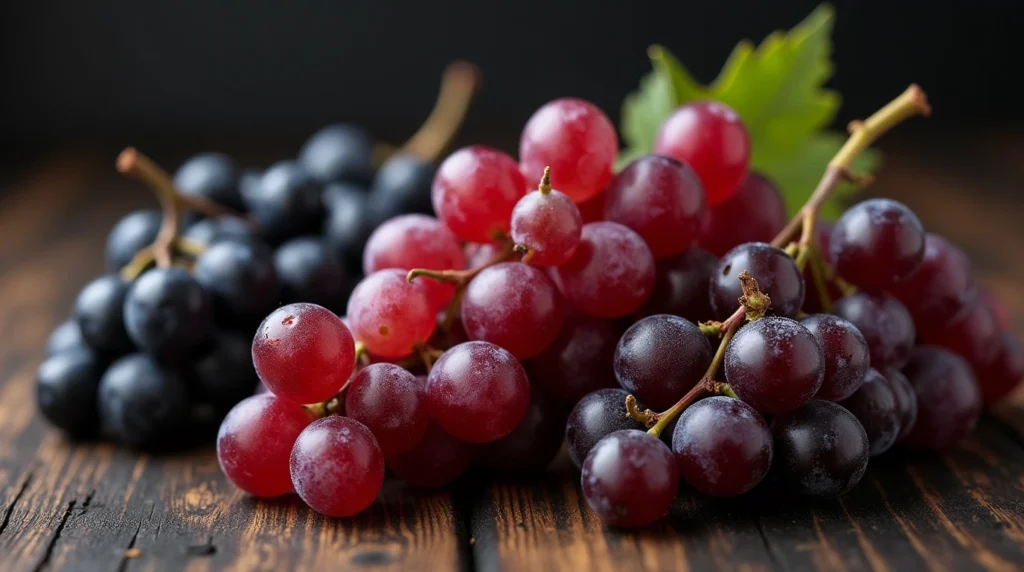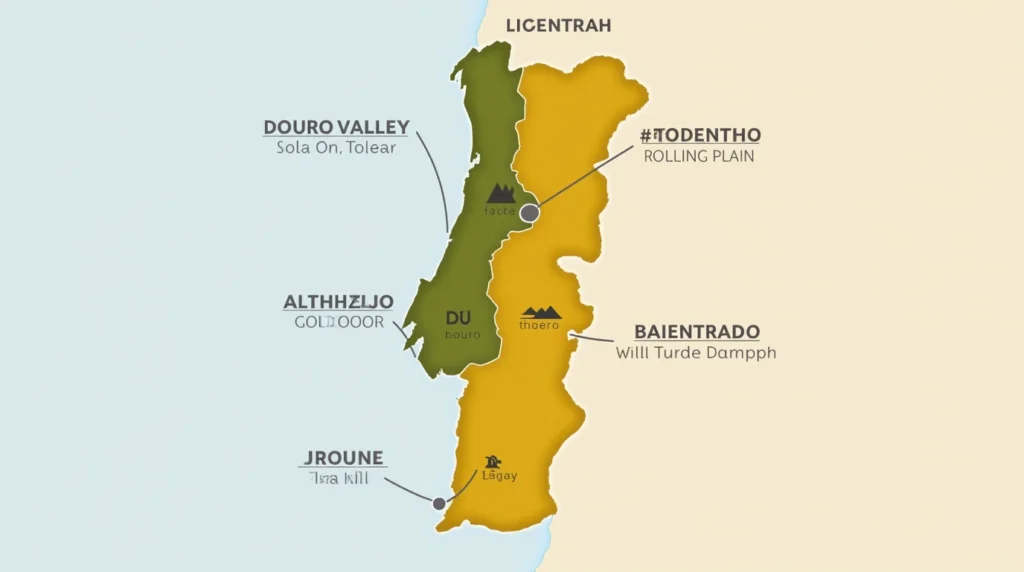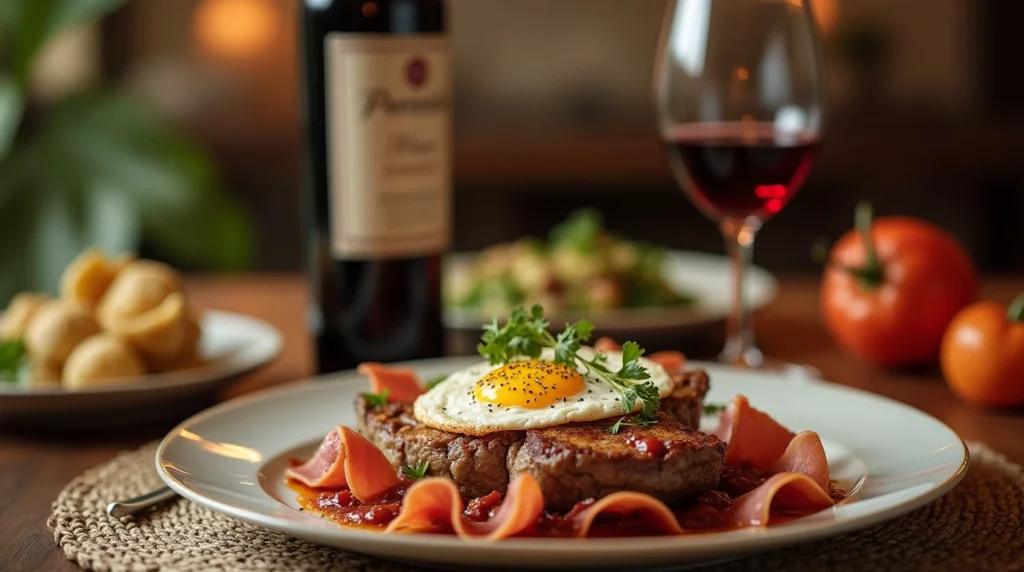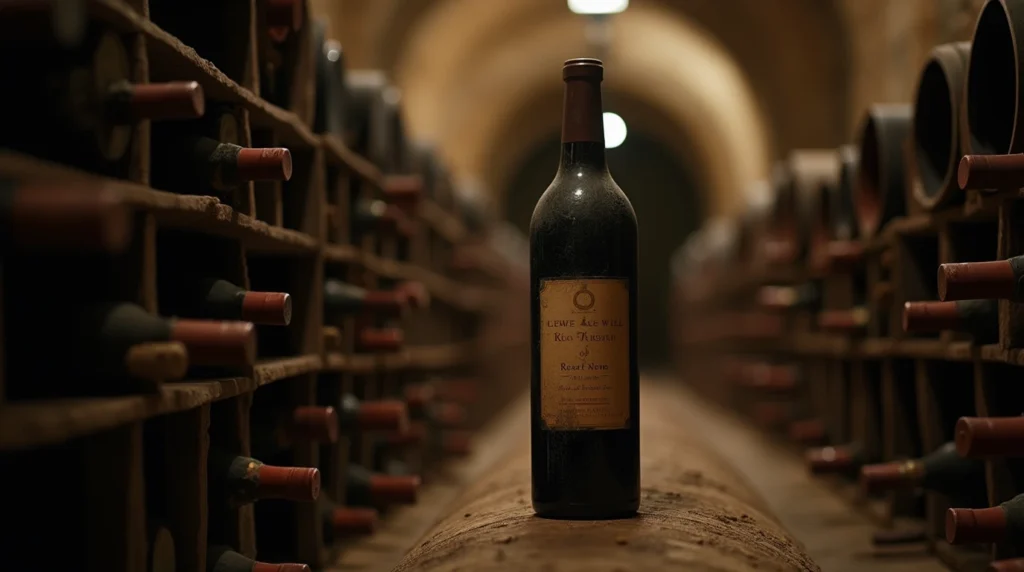Portugal, a land famed for its stunning coastlines, soulful Fado music, and, increasingly, its exceptional wines. While Port and Vinho Verde often steal the spotlight, a hidden gem awaits discovery: the world of red blend Portugal. These wines, crafted from a symphony of indigenous grape varieties, offer a complexity and character unlike anything else. Forget the predictable Cabernet Sauvignon and Merlot – get ready for Touriga Nacional, Tinta Roriz, and a whole host of intriguing grapes that will tantalize your taste buds. Are you ready to embark on a flavorful journey through the rolling hills and sun-drenched vineyards of Portugal? Let’s dive in!
Table of Contents
Unveiling the Allure of Portuguese Red Blends
Portuguese red blends aren’t just wines; they’re stories bottled. Each sip tells a tale of the land, the climate, and the generations of winemakers who have perfected their craft. These blends offer a unique opportunity to experience the true essence of Portugal, far from the mass-produced wines that dominate supermarket shelves. But what makes these blends so special? It’s a combination of factors, from the unique terroir to the diverse range of indigenous grapes. This guide will take you on a comprehensive exploration of this exciting wine category, covering everything from the key grape varieties to the best food pairings.
Why Portuguese Red Blends Are Gaining Popularity
In a world saturated with Cabernet Sauvignon and Merlot, consumers are increasingly seeking out wines with personality and authenticity. Portuguese red blends offer exactly that. Their unique flavor profiles, driven by indigenous grape varieties, provide a refreshing alternative to the usual suspects. Furthermore, the value proposition is often exceptional. You can find outstanding red blend Portugal wines at prices that significantly undercut comparable wines from other regions.
“Portuguese wines, especially the red blends, are offering incredible value for the quality. They represent a smart choice for wine lovers looking to expand their palate without breaking the bank.” – Wine Enthusiast
The rise of Portuguese cuisine on the global stage has also fueled interest in its wines. As more people discover the delights of dishes like cozido à portuguesa (a hearty stew) and bife à portuguesa (steak with ham and fried egg), they naturally seek out wines that complement these flavors. The versatility of red blend Portugal makes them perfect partners for a wide range of dishes.
What Makes a Red Blend “Portuguese”?
Simply put, a red blend is considered “Portuguese” if it predominantly features grape varieties native to Portugal and is produced within the country’s borders. While some international varieties like Syrah or Cabernet Sauvignon might be used in smaller proportions, the defining characteristic is the dominance of Portuguese grapes. This emphasis on indigenous varieties is what gives red blend Portugal its distinctive character and sets it apart from red blends produced elsewhere. It’s the careful selection and blending of these grapes that creates the harmonious and complex wines that are so highly regarded.
Decoding the Key Grape Varieties in Red Blend Portugal
The beauty of red blend Portugal lies in the diversity of its constituent grapes. Each variety brings its own unique set of characteristics, contributing to the overall complexity and flavor profile of the wine. Understanding these grapes is crucial to appreciating the nuances of Portuguese red blends. Think of it like learning the instruments in an orchestra – each one plays a vital role in creating the final symphony. So, let’s meet some of the stars of the show.
Touriga Nacional: The King of the Blend
Often hailed as Portugal’s finest red grape, Touriga Nacional is the backbone of many of the country’s best red blends. It’s a thick-skinned grape that produces wines with intense aromas of black fruit, floral notes (particularly violet), and hints of spice. Touriga Nacional contributes structure, tannins, and aging potential to the blend. Its concentrated flavors and firm structure make it a truly regal addition. Without Touriga Nacional, many red blend Portugal wines would lack the depth and intensity that define them.
Tinta Roriz (Aragonez): Adding Complexity and Structure
Known as Tinta Roriz in the Douro and Dão regions and Aragonez in the Alentejo, this grape is the Portuguese incarnation of Tempranillo. It adds bright acidity, red fruit flavors (cherry and plum), and a subtle earthiness to the blend. Tinta Roriz provides a crucial counterpoint to the more powerful Touriga Nacional, contributing to the overall balance and complexity of the wine. Think of it as the co-star, complementing and enhancing the lead actor’s performance.
Touriga Franca: The Aromatic Contributor
Another key player in Portuguese red blends, Touriga Franca is known for its aromatic intensity. It contributes floral aromas, as well as notes of blackberry, raspberry, and bergamot. Touriga Franca also adds a touch of elegance and finesse to the blend. It’s often considered the “perfume” of Portuguese red blends, adding a layer of complexity and intrigue to the overall aroma profile. It’s often blended with the bolder varieties to round out the flavor profile.
Trincadeira (Tinta Amarela): The Rustic Charm
Also known as Tinta Amarela, Trincadeira can be a bit of a wild card. It’s known for its rustic character, with notes of leather, herbs, and dark fruit. Trincadeira can be challenging to grow, but when handled well, it adds a unique complexity and a touch of the unexpected to the blend. Think of it as the quirky character in the movie – it might be a little rough around the edges, but it adds a distinctive flavor to the story.
Other Notable Grapes in Portuguese Red Blends
While Touriga Nacional, Tinta Roriz, and Touriga Franca are the most common, other grape varieties also play a significant role in red blend Portugal. These include:
- Baga: Known for its high acidity and firm tannins, Baga is often used in the Bairrada region to produce wines with aging potential.
- Alfrocheiro: This grape contributes red fruit flavors and a silky texture to the blend.
- Jaen: Found primarily in the Dão region, Jaen offers floral aromas and a vibrant acidity.

Exploring the Diverse Regions Producing Exceptional Red Blends
Portugal, though a relatively small country, boasts a remarkable diversity of terroirs, each contributing its unique character to the red blend Portugal. From the steep slopes of the Douro Valley to the sun-baked plains of the Alentejo – landscapes as varied and captivating as those found along the Costa Terra – each region offers a distinct expression of Portuguese winemaking. Understanding these regions is key to appreciating the diversity of styles within the category.
Douro Valley: The Iconic Region
Synonymous with Port wine, the Douro Valley is also a powerhouse for red blends. The region’s steep, terraced vineyards, planted along the banks of the Douro River, produce wines with concentration, structure, and aging potential. The hot, dry summers and cold winters contribute to the intensity of the grapes. Red blend Portugal from the Douro Valley often showcases a rich tapestry of flavors, with notes of black fruit, spice, and floral aromas. These wines are known for their ability to age gracefully, developing even more complexity over time.
Dão: Elegance and Freshness
Located south of the Douro, the Dão region is known for its elegant and aromatic red blends. The vineyards, planted at higher altitudes, benefit from cooler temperatures and granite-based soils. This results in wines with bright acidity, refined tannins, and a distinctive minerality. Red blend Portugal from the Dão often features Touriga Nacional, Tinta Roriz, and Alfrocheiro, creating wines that are both complex and approachable. They are often described as more “feminine” in style compared to the bolder wines of the Douro.
Alentejo: Bold and Ripe Flavors
The Alentejo region, in southern Portugal, is characterized by its vast plains and hot, dry climate. This results in red blends with ripe fruit flavors, full bodies, and smooth tannins. Aragonez (Tinta Roriz) thrives in this region, contributing to the wines’ structure and complexity. Red blend Portugal from the Alentejo is often characterized by notes of blackberry, plum, and chocolate. These wines are typically ready to drink upon release, offering immediate gratification.
Bairrada: Distinct Acidity and Earthiness
Located near the Atlantic coast, the Bairrada region experiences a cooler, wetter climate than other parts of Portugal. In contrast to the sun-drenched landscapes one might find on a Map of Western Algarve, Bairrada’s climate fosters a unique style of wine. The predominant grape variety is Baga, which produces wines with high acidity and firm tannins. Red blend Portugal from Bairrada can be challenging in their youth, but they develop beautifully with age, revealing complex flavors of earth, spice, and red fruit. These wines are known for their distinctive acidity and their ability to pair well with food.

Common Problems and Solutions When Enjoying Red Blend Portugal
Like any wine category, enjoying red blend Portugal can sometimes present challenges. Here are some common problems and practical solutions to enhance your experience:
Problem: Overly Tannic Wines
Some Portuguese red blends, particularly those made with Baga or from certain vintages in the Douro, can be quite tannic, especially when young. This can result in a mouth-puckering sensation that detracts from the overall enjoyment.
Solution: Decanting and Pairing with Rich Foods
Decanting the wine for an hour or two before serving can help to soften the tannins and allow the wine’s aromas to open up. Pairing tannic wines with rich, fatty foods like grilled steak, roasted lamb, or aged cheese can also help to mitigate the tannins. The fat in the food binds to the tannins, making the wine taste smoother and more balanced.
Problem: Lack of Familiarity with Portuguese Grape Names
Let’s face it: Portuguese grape names like Touriga Nacional, Tinta Roriz, and Trincadeira can be a mouthful! This unfamiliarity can make it difficult to navigate the world of red blend Portugal and choose wines that you’ll enjoy.
Solution: Using Wine Apps and Asking for Recommendations
Fortunately, there are many helpful resources available. Wine apps like Vivino and Delectable allow you to scan wine labels and access information about grape varieties, tasting notes, and user reviews. Don’t be afraid to ask for recommendations from your local wine merchant or sommelier. They can guide you towards wines that suit your taste preferences and help you discover new favorites.
Problem: Difficulty Finding Reputable Bottles Outside Portugal
While Portuguese wines are becoming increasingly popular, they can still be difficult to find outside of Portugal, especially in certain regions. This can make it challenging to explore the diversity of red blend Portugal and discover hidden gems.
Solution: Exploring Online Retailers and Specialty Wine Shops
Online retailers like Wine.com and Wine Library offer a wide selection of Portuguese wines, often at competitive prices. Specialty wine shops that focus on international wines are also a great resource. These shops typically have knowledgeable staff who can provide personalized recommendations and help you find rare or hard-to-find bottles.
“Don’t be afraid to venture beyond the familiar. The world of Portuguese red blends is full of surprises, and you never know what hidden gem you might discover.” – Jancis Robinson, Master of Wine
Food Pairing: Enhancing Your Red Blend Portugal Experience
Wine, and yes even beer, and food pairing is an art, and red blend Portugal offers a fascinating canvas for culinary exploration. The diversity of styles within the category means that there’s a Portuguese red blend to complement a wide range of dishes. From traditional Portuguese cuisine to international flavors, finding the perfect pairing can elevate your dining experience to new heights. Forget the rigid rules and embrace experimentation – the most important thing is to find combinations that you enjoy.
Classic Portuguese Dishes That Shine with Red Blends
To truly appreciate the character of red blend Portugal, it’s essential to explore its compatibility with classic Portuguese cuisine. Here are a few pairings to get you started:
- Cozido à Portuguesa (Portuguese Stew): This hearty stew, featuring a variety of meats and vegetables, demands a full-bodied red blend from the Alentejo or Douro. The wine’s ripe fruit flavors and smooth tannins will complement the richness of the dish.
- Bife à Portuguesa (Steak with Ham and Fried Egg): This iconic dish, featuring a juicy steak topped with ham, a fried egg, and a rich sauce, pairs perfectly with a medium-bodied red blend from the Dão or Douro. The wine’s acidity will cut through the richness of the sauce, while its fruit flavors will complement the steak.
- Arroz de Pato (Duck Rice): This flavorful rice dish, cooked with duck, chorizo, and bacon, calls for a complex red blend with earthy notes, such as those from the Bairrada region. The wine’s acidity will balance the richness of the duck, while its earthy flavors will complement the chorizo and bacon.
- Sardinhas Assadas (Grilled Sardines): Surprisingly, a light-bodied, slightly chilled red blend Portugal can be a fantastic pairing for grilled sardines, especially when they are freshly caught and seasoned with sea salt. The wine’s acidity will cut through the oiliness of the sardines, while its red fruit flavors will complement the smoky notes from the grill.
International Cuisine Pairings: Think Beyond Portugal
While red blend Portugal shines with Portuguese cuisine, it’s also surprisingly versatile when paired with international flavors. Here are a few unexpected pairings to try:
- Grilled Lamb Chops: A medium-bodied red blend from the Dão or Douro is an excellent match for grilled lamb chops. The wine’s tannins will complement the richness of the lamb, while its herbal notes will enhance the savory flavors.
- Spicy Asian Cuisine: Believe it or not, a lighter-bodied, fruit-forward red blend Portugal can be a surprisingly good match for spicy Asian dishes. The wine’s sweetness will help to tame the heat, while its acidity will cleanse the palate. Look for blends with a touch of residual sugar for an even better pairing.
- Pizza with Sausage or Pepperoni: A medium-bodied red blend with bright acidity and red fruit flavors is a classic pairing for pizza with sausage or pepperoni. The wine’s acidity will cut through the richness of the cheese and meat, while its fruit flavors will complement the savory toppings.
- Mexican Food (Tacos, Enchiladas): A fruit-forward red blend Portugal can stand up to the bold flavors of Mexican food. Avoid overly tannic wines, as they can clash with the spice. Opt for blends with a touch of sweetness and bright acidity to balance the heat and richness of the dish.

How to Choose the Right Red Blend Portugal for Your Taste
With such a diverse range of styles and regions to choose from, selecting the perfect red blend Portugal can feel overwhelming. Here are a few tips to help you navigate the selection process and find wines that you’ll truly enjoy:
Understanding Wine Labels: Decoding the Details
The wine label is your first point of contact with the wine, and it contains valuable information that can help you make an informed decision. Pay attention to the following details:
- Region: The region of origin (e.g., Douro, Dão, Alentejo) provides clues about the wine’s style and characteristics.
- Grape Varieties: The label may list the grape varieties used in the blend. This can give you an idea of the wine’s flavor profile.
- Vintage: The vintage (year of harvest) can influence the wine’s quality and character. Research the vintage conditions in the region to understand what to expect.
- Producer: The producer’s reputation can be a good indicator of the wine’s quality. Look for producers that are known for their commitment to quality and sustainability.
- Alcohol Content: The alcohol content can give you an idea of the wine’s body and intensity. Higher alcohol wines tend to be fuller-bodied and more concentrated.
- Denomination of Origin (DOC/DOP): This indicates that the wine meets certain quality standards and is produced within a specific region.
Considering Vintage and Producer Reputation
Beyond the label, consider the vintage and the producer’s reputation. Just as collectors value the craftsmanship and artistry of Portugal Pottery, discerning wine enthusiasts recognize the significance of vintage and producer. Some vintages are simply better than others, due to favorable weather conditions. Researching the vintage conditions in the region can help you make an informed decision. A producer’s reputation, much like the consistent quality associated with renowned pottery makers, can also be a good indicator of the wine’s quality. Look for producers that have a track record of producing consistently excellent wines.
Matching the Blend to the Occasion
Finally, consider the occasion when choosing a red blend Portugal. A light-bodied, fruit-forward blend might be perfect for a casual summer barbecue, while a full-bodied, complex blend might be more appropriate for a formal dinner party. Think about the food you’ll be serving and the overall atmosphere you want to create.
Investing in Red Blend Portugal: Cellaring Potential and Value
While many red blend Portugal wines are delicious upon release, some have the potential to age gracefully, developing even more complexity and nuance over time. Investing in age-worthy Portuguese red blends can be a rewarding experience, both for your palate and your wallet. As the wines mature, they can develop tertiary aromas of leather, tobacco, and earth, adding another layer of intrigue to their flavor profile. Moreover, some Portuguese red blends offer exceptional value for money, making them an attractive option for wine collectors.
Which Red Blends Age Gracefully?
Not all red blend Portugal wines are created equal when it comes to aging potential. Wines from the Douro Valley, particularly those made with Touriga Nacional and Tinta Roriz, often have the structure and tannins necessary to age for a decade or more. Wines from the Bairrada region, made with Baga, can also age beautifully, developing complex earthy and spicy notes. Look for wines from reputable producers and from vintages that were known for their concentration and balance.
However, wines from the Alentejo, while delicious when young, are generally not meant for long-term aging. They are best enjoyed within a few years of release. When considering cellaring potential, pay attention to the wine’s tannin structure, acidity, and concentration of flavors. Wines with high tannins, good acidity, and concentrated flavors are more likely to age gracefully.
Emerging Trends in Portuguese Red Blend Production
The world of red blend Portugal is constantly evolving, with winemakers experimenting with new techniques and embracing sustainable practices. Here are a few emerging trends to watch:
- Organic and Biodynamic Viticulture: More and more Portuguese winemakers are adopting organic and biodynamic farming practices, which emphasize the health of the soil and the ecosystem. This results in wines that are more expressive of their terroir and that are produced in a more environmentally friendly way.
- Minimal Intervention Winemaking: Some winemakers are embracing a “hands-off” approach to winemaking, using minimal intervention techniques such as native yeast fermentation and minimal filtration. This allows the wines to express their natural character and complexity.
- Focus on Indigenous Grape Varieties: There is a growing interest in preserving and promoting Portugal’s unique indigenous grape varieties. Winemakers are exploring the potential of lesser-known grapes, creating wines that are truly distinctive and expressive of the country’s winemaking heritage.
- Sustainable Packaging: With increasing environmental awareness, many wineries are now using lighter bottles, recycled materials, and alternative closures to minimize their environmental impact.

Beyond the Bottle: Experiencing Portuguese Wine Culture
Exploring red blend Portugal is about more than just tasting the wine; it’s about immersing yourself in the rich and vibrant Portuguese wine culture. From visiting picturesque vineyards to participating in local wine festivals, there are countless ways to experience the passion and tradition that underlie Portuguese winemaking.
Visiting Portuguese Vineyards: A Wine Lover’s Dream
Portugal offers a plethora of opportunities for wine tourism, allowing you to explore the vineyards, meet the winemakers, and learn about the winemaking process firsthand. Many vineyards offer tours and tastings, providing a unique glimpse into the world of red blend Portugal. Here are a few tips for planning your visit:
- Research and Book in Advance: Popular vineyards can book up quickly, especially during peak season, so it’s best to research and book your tours and tastings in advance.
- Consider the Region: Choose a region that interests you, whether it’s the dramatic landscapes of the Douro Valley, the elegant estates of the Dão, or the sun-drenched vineyards of the Alentejo.
- Look for Family-Run Estates: Many family-run estates offer a more intimate and authentic experience, allowing you to connect with the winemakers and learn about their family’s history and traditions.
- Combine Wine Tasting with Local Cuisine: Many vineyards offer on-site restaurants or partner with local restaurants to provide a complete culinary experience.
- Be Respectful and Engaged: Ask questions, show genuine interest in the winemaking process, and be respectful of the environment and the local culture.
Participating in Wine Festivals and Events
Portugal hosts a variety of wine festivals and events throughout the year, offering a fantastic opportunity to sample a wide range of red blend Portugal wines, meet winemakers, and learn about the latest trends in the industry. These events often feature live music, food stalls, and other entertainment, creating a festive and memorable atmosphere. Check local listings and wine publications for information about upcoming events. Some notable events include:
- Essência do Vinho (Porto): One of the largest and most prestigious wine events in Portugal, featuring hundreds of Portuguese and international wines.
- Vinhos no Douro (Douro Valley): A showcase of the Douro Valley’s finest wines, held in the heart of the region.
- Festa das Vindimas (Various Regions): Harvest festivals celebrated in various wine regions throughout Portugal, offering a glimpse into the traditional grape harvesting process.
Conclusion: Embracing the World of Red Blend Portugal
The world of red blend Portugal is a treasure trove of flavors, aromas, and experiences waiting to be discovered. From the unique grape varieties to the diverse terroirs and the passionate winemakers, there’s so much to appreciate about these exceptional wines. By embracing experimentation, seeking out new producers, and immersing yourself in Portuguese wine culture, you can unlock a world of delicious possibilities.
The Future of Portuguese Red Blends
The future of red blend Portugal looks bright. With increasing recognition on the international stage, a growing emphasis on sustainable practices, and a commitment to preserving indigenous grape varieties, Portuguese winemakers are poised to continue producing exceptional wines that capture the essence of their terroir. Expect to see more innovative blends, a greater focus on quality, and a wider availability of Portuguese wines in international markets.
Final Thoughts: Why You Should Explore These Unique Wines
In a world saturated with homogenous wines, red blend Portugal offers a refreshing alternative. These wines are not only delicious and versatile but also offer incredible value for money. By exploring the world of Portuguese red blends, you’re supporting sustainable winemaking, preserving indigenous grape varieties, and discovering a rich cultural heritage. So, next time you’re looking for a new wine to try, venture beyond the familiar and embrace the unique charm of red blend Portugal. You might just find your new favorite wine.



